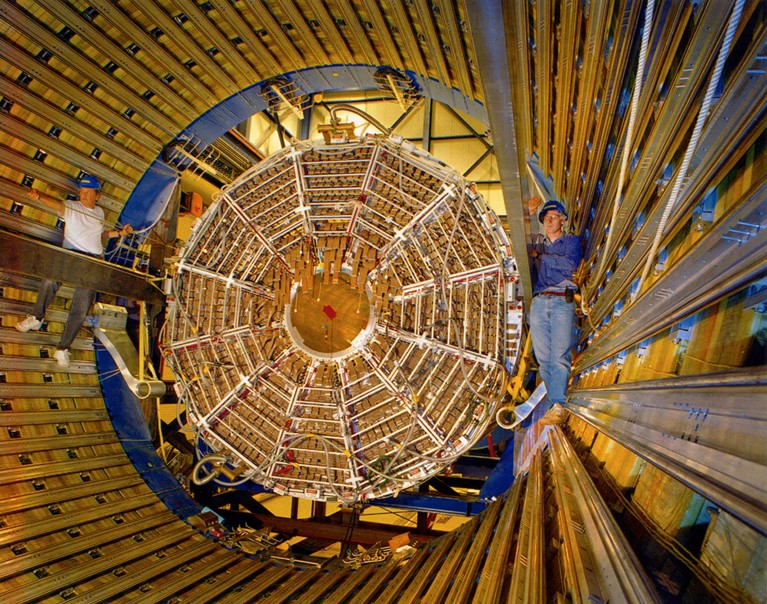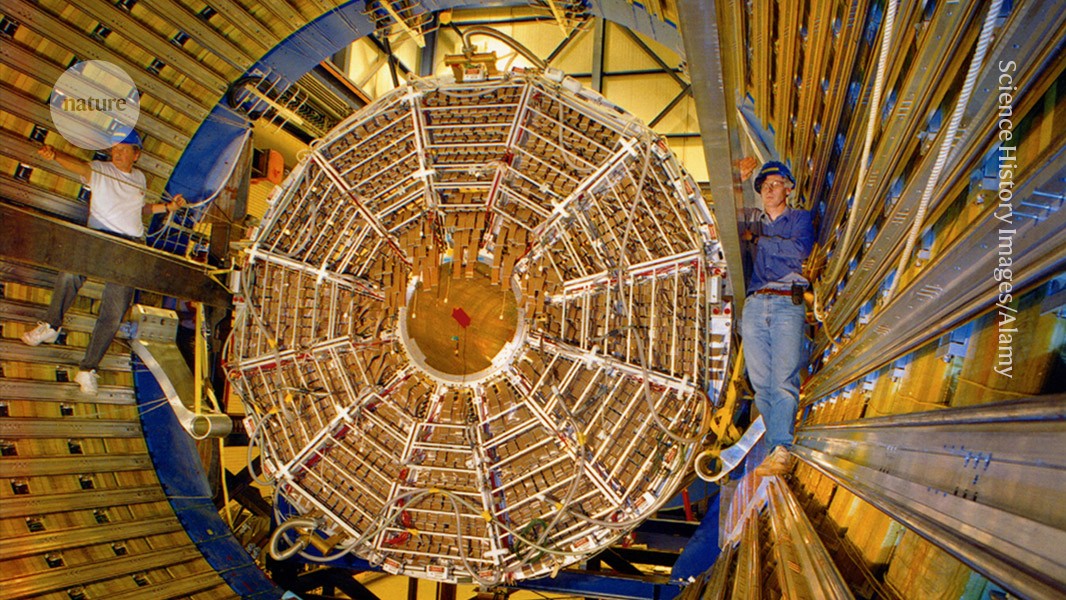
Inside the Relativistic Heavy Ion Collider’s STAR detector, which can track the thousands of particles produced when ions collide.Credit: Science History Images/Alamy
Physicists have found a new way to study the shape of atomic nuclei — by obliterating them in high-energy collisions. The method could help scientists to better understand nuclei’s shapes, which, for example, influence the rate at which elements form in stars and help to determine which materials make the best nuclear fuel.
“The shape of nuclei affects almost all aspects of atomic nucleus and nuclear processes,” says Jie Meng, a nuclear physicist at Peking University in Beijing. The new imaging method, published in Nature on 6 November, is “important and exciting progress”, he says.
Atomic nucleus takes two shapes
A team at the Relativistic Heavy Ion Collider (RHIC) at Brookhaven National Laboratory in Upton, New York, collided two beams of uranium-238 — and later, two beams of gold — at extreme energies. They hit them “so hard that we basically melted the nuclei into a soup”, says co-author Jiangyong Jia, a physicist at Stony Brook University in New York.
The hot plasma produced by the collisions expanded under pressure very rapidly, in a way that was related to the nuclei’s initial shape. By using a detector called Solenoidal Tracker at RHIC, or STAR, to find the momentum of each of the thousands of particles created by both types of collision and matching the results with models, the team could “roll back the clock to infer the shape of the nuclei”, says Jia.
Hidden figures
An atomic nucleus is made up of protons and neutrons, which, like electrons, inhabit energy shells. Generally, the particles take on a shape that minimizes the energy of the system. Like a droplet of liquid, the nucleus can take on a variety of shapes, including that of a pear, American football or peanut shell. A nucleus’s shape is “very hard to predict from theory”, says Jia. It can also change over time owing to quantum fluctuations.
Past experiments exploring shape involved deflecting low-energy ions off the nuclei. This method — called Coulomb excitation — excites the nuclei, and the radiation they emit as they fall back to the ground state reveals aspects of their shape. But the timescale is relatively long, so this kind of imaging can give only a long-exposure shot showing the average of any fluctuations in shape.
‘The standard model is not dead’: ultra-precise particle measurement thrills physicists
By contrast, the high-energy collision method gives an instant snapshot of nuclei during impact. It is a more direct method, which makes it more suitable for studying exotic shapes, says Jia.
The technique confirmed that gold had an almost spherical shape that was consistent from one image to the next. By comparison, uranium changed across the snapshots as the nuclei collided in different orientations. This allowed researchers to calculate the relative lengths of its nucleus in three spatial dimensions, indicating that uranium is not only elongated, but also slightly squeezed in one dimension, like a deflated American football.
“I find it fascinating that it worked” and that other nuclear processes did not influence the particle emission and obscure the deformation, says Magdalena Zielińska, a nuclear physicist at the French Alternative Energies and Atomic Energy Commission near Paris.
Hard or soft?
This kind of imaging could help with the challenging task of distinguishing between nuclei that are ‘rigid’, with well-defined shapes, and ‘soft’ fluctuating ones, says Zielińska.
Jia says his team would also like to apply the method to study the differences between lighter ions, such as oxygen and neon. Oxygen nuclei are nearly spherical, whereas neon nuclei — which carry an extra two protons and two neutrons — are thought to bulge out. Comparing their shapes would allow researchers to understand how protons and neutrons form clusters in the nuclei, says Jia.
Information about shape can also reveal whether nuclei are likely to interact or undergo nuclear fission, and can boost the chance of detecting a process called neutrino-less double β decay, which could help solve some long-standing mysteries in physics. Some 99.9% of visible matter resides in the centre of the atoms, says Jia. “Understanding the nuclear building block is basically at the heart of the understanding who we are.”




